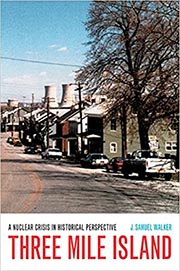Three Mile Island: A Nuclear Crisis in Historical Perspective
by J. Samuel Walker
Reviewed September 10, 2004
 On March 28, 1979, the alarms in the control room of Three Mile Island (TMI) nuclear power plant began shrieking. For five days, the world followed the efforts of authorities to prevent the crippled plant from suffering further damage to the reactor. In Three Mile Island: A Nuclear Crisis in Historical Perspective, J. Samuel. Walker, the official historian of the Nuclear Regulatory Commission (NRC) provides "the first comprehensive scholarly account" of the incident. This book captures the high drama of surrounding the accident by providing a moment-by-moment account of the accident itself. Walker brings to life the players who dealt with the emergency: the Nuclear Regulatory Commission, the state of Pennsylvania, the White House and a cast of scientists and reporters.
On March 28, 1979, the alarms in the control room of Three Mile Island (TMI) nuclear power plant began shrieking. For five days, the world followed the efforts of authorities to prevent the crippled plant from suffering further damage to the reactor. In Three Mile Island: A Nuclear Crisis in Historical Perspective, J. Samuel. Walker, the official historian of the Nuclear Regulatory Commission (NRC) provides "the first comprehensive scholarly account" of the incident. This book captures the high drama of surrounding the accident by providing a moment-by-moment account of the accident itself. Walker brings to life the players who dealt with the emergency: the Nuclear Regulatory Commission, the state of Pennsylvania, the White House and a cast of scientists and reporters.
The book opens by laying the foundation of nuclear power in America: the public debate of nuclear power before TMI, the regulation of nuclear power plants, and how the industry sought to prevent accidents or minimize the impact of such an event.
In his analysis of the worst nuclear power accident in the United States, Walker succeeds in presenting all sides of this extremely complicated and highly controversial subject matter. He concludes the book was a survey of the immediate and long-term impacts of the accident. It is a thoroughly researched history.
Three Mile Island: A Nuclear Crisis in Historical Perspective provides a superb account of the accident and the efforts to understand and cope with it into a broader historical and regulatory context.